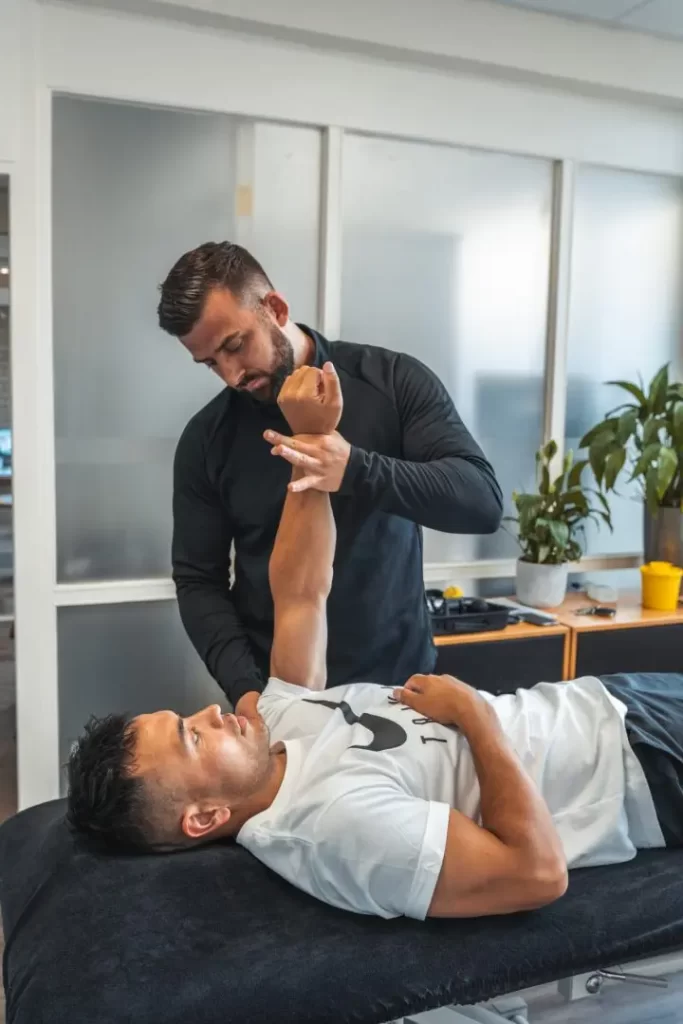Quadriceps activation failure
Not being able to properly tighten your upper leg (quadriceps) presents difficulties during rehabilitation after knee surgery, especially during a anterior cruciate ligament rehabilitation. This leads to you not being able to actively (or adequately) stretch your knee. There are several factors that contribute to quadriceps activation failure. Fortunately, we also have good techniques for re-learning the conscious control of the quadriceps. This recurs in every knee rehabilitation. Especially in the first phase after surgery. In this blog, we would like to tell you more about the background of quadriceps activation failure and the options we have to treat it properly.

Causes for quadriceps activation failure
In many knee injuries but certainly after almost every knee surgery, quadriceps activation failure is seen at the beginning. In the first phase of any knee rehabilitation, much attention is paid to regaining this activation. This is because it is known that being able to stretch properly is very important to also be able to walk properly. In addition, we see that people with good knee stretching are more satisfied with their rehabilitation than those who do not get good stretching. A number of factors are known to have a relationship with quadriceps activation failure. For example, we see that after knee surgery, people move and load much less than normal. This causes a rapid decline in muscle strength and muscle mass, making it harder to control the muscles. Something that is also seen as a common cause for quadriceps activation failure is AMI (arthogenic muscular inhibition) .AMI is a reflex response after surgery or knee injury. The term represents the inability to tighten the muscle without an obvious anatomical reason. This is because there is no damage to the muscle or to the nerves controlling the quadriceps. In practice, we see quadriceps activation failure persisting long after the onset of these symptoms. AMI probably results from a protective mechanism after severe knee injury. However, quadriceps activation failure can significantly hamper the rehabilitation process. A natural phenomenon but not always convenient so.
About the Quadriceps
The quadriceps femoris is a four-member muscle at the front of the thigh. These muscles mainly provide knee extension. The rectus femoris is the only one that also has a function over the hip because it has its attachment above the hip joint. This helps in flexing the hip. The quadriceps are important in our movement pattern because proper knee extension and sufficient control and strength are needed for various daily activities. Think of activities like walking, running, getting up from a chair but also climbing stairs. We also see that proper stretching and control of the quadriceps are important for getting a quiet knee (no swelling, pain, heat) after knee injury or knee surgery.
Motor control
Motor control is a fancy word for control over the direction and movement of our body. Among other things, our central nervous system plays an important role in this along with the various sensors in muscles and tendons. In quadriceps activation failure, we see that the nerve stimulus that provides control to the muscle cannot be processed as well or at all. By training, we can increase this stimulus frequency, creating a stronger tightening in the muscle.
Physiotherapy for quadriceps activation failure
At Fysio Fitaal in Tilburg, we use NMES (neuromuscular electrostimulation). By means of electrodes, we give an extra impulse from the outside, creating better muscle tightening. As the name suggests, it is a neuromuscular tool; we mainly try to influence the stimulation that causes the muscle to tighten. In this way, we stimulate conscious tightening and relaxing of the thigh muscles. In principle, this is always done actively, i.e. while you are exercising yourself. We can also use exentric exercise therapy during rehabilitation. Muscle tightening can be concentric, eccentric and isometric. Concentric means that the muscle shortens. Eccentric means the muscle delivers force while the muscle fibres lengthen and isometric is when you deliver force in the same position, so the muscle does not shorten or lengthen. A muscle can deliver more force eccentrically than concentrically alone. So you can brake more kilos than lift them up. Eccentric training is an effective method to improve quadriceps activation and strength.
Making an appointment at FysioFitaal
We work from multiple locations in Tilburg, always close by for professional and accessible physiotherapy. Fill in the contact form and we will contact you soon. Together, we will work on your recovery!

